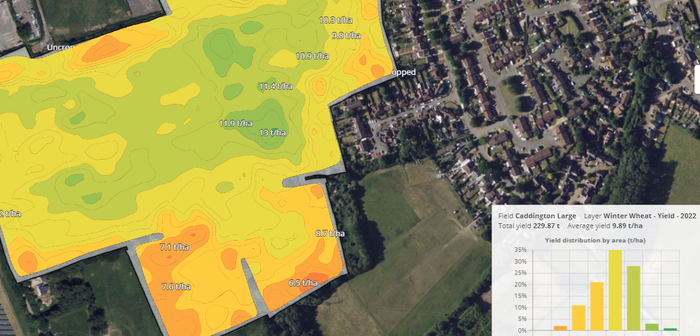It’s the level of detail that has been the impetus for change – this is what Kensworth grower David Woods has to say about his experience of using the Omnia Digital Farming platform.
Precision farming is nothing new to the 335ha farming business, DH Woods & Sons near Dunstable, that has been variably drilling crops for twelve years.
Having to farm across a range of soil types from heavy clay to chalk with lots of flints, Mr Woods was open to the concept of variable rate drilling as this allowed him to tailor seed rates to soil type and condition.
Variable drilling results in a more even crop resulting in less disease pressure, less risk of lodging, better use of inputs and higher yields.
“We have always approached variable rate drilling with a mindset that it is not about saving seed, but ensuring that we are using seed as efficiently as we can; drilling the right amount of seed for the soil in a particular area at a certain time. Its all about marginal gains, even a 1% improvement in yields pays for any extra seed that may be required, “says Mr Woods.
“Historically we have based our plans on a limited amount of data based on more traditional methods of soil sampling which then created ‘zones’ across fields,” he says.
However after having the whole farm Terramapped summer 2022 and moving over to the Omnia Digital Farming system, Mr Woods has been very impressed by the level of detail and accuracy from TerraMap – having shown up clear variations in the soils that had not been seen before.
“It has brought about a complete step change in the level of information and given us a much deeper insight into what is happening in our soils than we ever thought possible.”
TerraMap is Hutchinsons revolutionary soil scanning service that provides greater definition and more accurate soil maps than any other system enabling growers and agronomists to make the most of precision technology.
It does this by providing high definition mapping of all common nutrient properties, pH, soil texture, organic matter and CEC as well as elevation and plant available water. It also measures the levels of P, K, Mg, pH and % of clay, sand, silt, texture and elevation as well as calcium, manganese, boron, copper, molybdenum, iron, zinc, sulphur, OM, CEC and plant available water and soil organic carbon
“This offers a unique understanding of how and why soil performs the way it does, and highlights in-field variations with clear digital maps. Analysing the data through Omnia, further allows tailored management plans and variable application maps to be created quickly and easily,” explains Omnia sales manager, Chris Hoskins, who has worked closely with Mr Woods to introduce Omnia to the business.
Mr Woods says: “TerraMap made it pretty clear that we had been generating variable rate plans on quite shallow and inaccurate data. For example pH is actually much more variable than we thought, as well as our soil texture.
“So going forward we will use this new level of data from TerraMap to generate much more accurate and precise drilling plans that work on a sub-field basis.”
It’s not just about relying on the data though, points out Mr Woods. “The dynamics of factors within fields are always changing and it’s important to take account of this. The day before we drill a field, we always walk it, just to confirm what the plans are telling us to do and then if we need to tweak the plans we do – say for example if there are slug issues that we need compensate for. “
“With Omnia it is really easy and straightforward to do this, so for example by creating a slug pressure map that we overlay onto the other layers and re-run the plans.”
Highlighting consistently less profitable areas
Omnia’s yield performance mapping allows users to identify and map areas of fields by categorising them in terms of the consistency of performance such as poorly consistent yield, good consistent yield etc – and adapt crop management accordingly, explains Mr Hoskins.
Given the continued pressure on margins, Mr Woods was keen to try this tool.
“It’s all very well looking at one year of yield data, but the real value is to be able to overlay several years of yields which give you the trends – and this is significant,” he says.
“In doing so, we have identified areas of fields that are inconsistent- don’t yield well year in and out – so we can focus on why and what can be done to address this, or where underlying problems cannot be rectified, we may consider taking these out of production and putting them into some sort of environmental stewardship option.”
“Looking at an overview of yield performance over several years allows us to make much more informed strategic business decisions going forward.”
“Omnia is not fussy about using data from other systems so we were able to input all of the old yield maps, and soil information into the system and then and overlaying this information with more recent yield and Terramap data.”
Mr Hoskins adds: “The next step is to input actual financial costings information into Omnia and use its cost of production mapping functionality to highlight areas of the farm and individual fields that can consistently deliver a profit, and those that cannot.”




